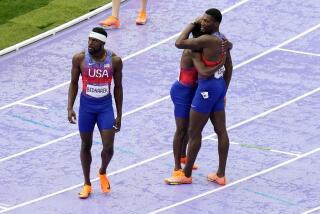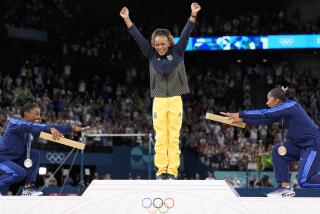No Longer Any Questions of Politics : Track and field: World’s best will finally get down to business.
- Share via
TOKYO — It has been difficult in recent days to determine whether people were gathering here from throughout the world for track and field’s third World Championships or for a meeting of the United Nations.
Delegates to the International Amateur Athletic Federation, which governs track and field, discussed apartheid in South Africa. Soviets discussed the aborted coup in their country. Germans discussed reunification.
But, on Saturday, Tokyo time, politics began to fade into the background as competition among 1,705 athletes from 168 countries opened at the National Stadium in a nine-day meet that the sport’s purists insist is of higher quality than any other in the world, including the Summer Olympics.
The first World Championships were held only eight years ago and there are still five athletes from it competing at the international level--the United States’ Carl Lewis in the 100 meters, long jump and 400-meter relay, and Greg Foster in the high hurdles; Germany’s Martine Hellmann in the discus and Sabine Busch in the 1,600-meter relay, and the Soviet Union’s Sergei Bubka in the pole vault.
Others who established themselves at the sport’s highest level in the ‘80s and are attempting to remain there include the United States’ Jackie Joyner-Kersee in the heptathlon and long jump, Jamaica’s Merlene Ottey in the 100 and 200, Cuba’s Ana Quirot in the 800 and Javier Sotomayor in the high jump, Portugal’s Rosa Mota in the marathon, Morocco’s Said Aouita in the 1,500, and Germany’s Ulf Timmerman in the shotput and Juergen Schult in the discus.
Also here are the emerging young stars of the ‘90s, such as the United States’ Leroy Burrell in the 100, Michael Johnson in the 200 and Dan O’Brien in the decathlon, Algeria’s Noureddine Morcelli in the 1,500, Morocco’s Khalid Shah in the 10,000, Zambia’s Samuel Matebe in the intermediate hurdles, Germany’s Katrin Krabbe in the 100 and 200 and France’s Marie-Jose Perec in the 400.
In short, virtually everyone in the sport who is anyone, or aspires to be, is in Tokyo--except for the South Africans. After three decades as an outcast because of their government’s policy of racial separation, they received an invitation but declined either because their track and field officials were not organized, their athletes were not prepared, or both.
Earlier this week, it appeared that the Soviets might also be absent. But despite the turmoil in their country, four athletes, including Bubka, were allowed to leave from Sheremetyvo Airport outside Moscow on Tuesday, arriving at Narita irport here a day later. They were joined Thursday by the remaining 156 members of the delegation, who flew here from a training camp in Vladivostok.
“My flight was on the second day of the problems,” Bubka said at a news conference. “In airport, everything was OK. But when I take car to airport, I see 70 tanks going to Moscow.
“It was very hard for me. It was possible for me to come here, but my family stays in Russia. It was very serious, but, now, completely different. Everything is good now.”
Because of a back injury, Bubka, 27, was ranked third in the world last year. But with his injury healed, a new coach and an arrangement with the Soviet sports committee that allows him to retain 80% of all he earns, he has set world records eight times this year--four times indoors and four outdoors. The most recent was an outdoor record of 20 feet 1/4 inch set Aug. 5 at Malmo, Sweden. Since 1984, he has broken world records, indoors and outdoors, 28 times.
The only track and field athlete who has been more impressive since 1983 has been Lewis, 30, who easily advanced past the first round of the 100 meters Saturday in a time of 10.12. He also is entered in the long jump and the 400-meter relay. He won all three events in 1983, then repeated in two of them four years later after losing in the 100 to Ben Johnson.
Johnson, attempting to regain his form after serving a two-year suspension for using anabolic steroids, is here this time only as a potential member of Canada’s 400-meter relay team.
But Lewis does not lack for competition in the 100, in which he is expected to race Santa Monica Track Club teammate Burrell and 1988 Olympic silver medalist Linford Christie of Great Britain in Sunday’s final. Burrell, who trains with Lewis in Houston, ran the distance in 9.90, breaking the world record, in the national championships this summer at New York, but Lewis was barely a step behind in 9.93.
“If I run the best race I can run, I have a great shot at winning and running very fast,” Lewis said. “If we both run the best we can, we could have another world record.”
Lewis leads a U.S. team that could win as many as 12 gold medals, four more than at Helsinki, Finland, in 1983 and three more than at Rome in 1987. East Germany won the most gold medals at each of those meets with 10. But there is no more East Germany, which was bemoaned by one of that country’s most celebrated athletes, half-miler Sigrun Wodars Grau.
“(Despite reunification,) there is not really one German team,” she said. “There are still some mixed feelings about it. I think the team needs to work a little more to develop. Maybe it will be OK in the future.”
But if there is not an East Germany at the World Championships, there are athletes here from 14 countries that have never been represented before. One of them, Namibia, might even win a medal as Frank Fredericks, who competes for Brigham Young, could become more than a footnote in the Lewis-Burrell duel in the 100.
More to Read
Go beyond the scoreboard
Get the latest on L.A.'s teams in the daily Sports Report newsletter.
You may occasionally receive promotional content from the Los Angeles Times.










